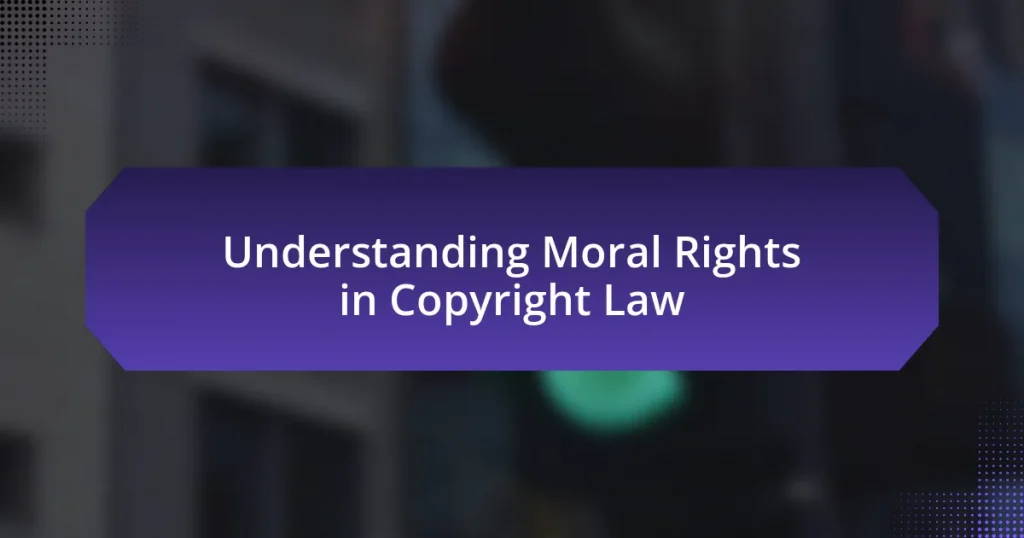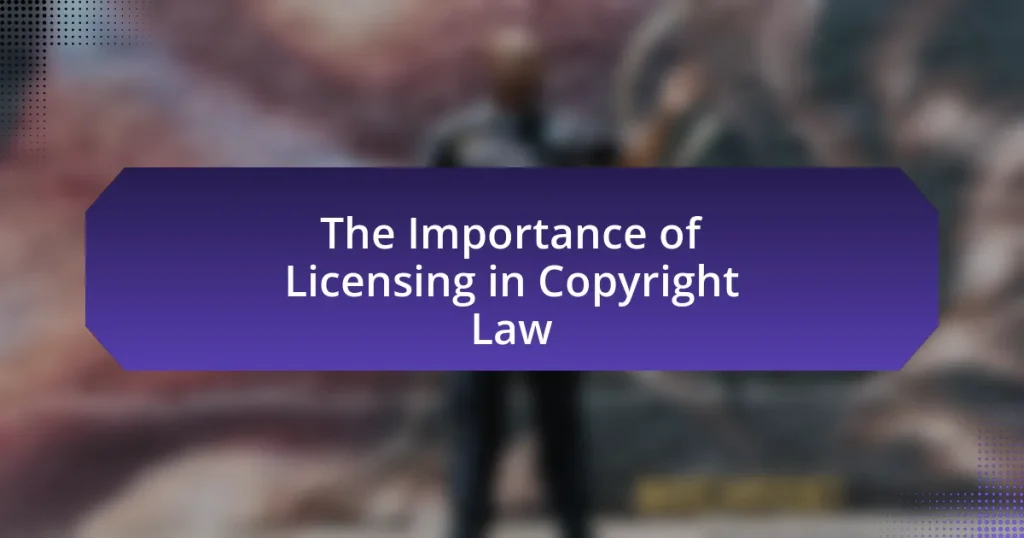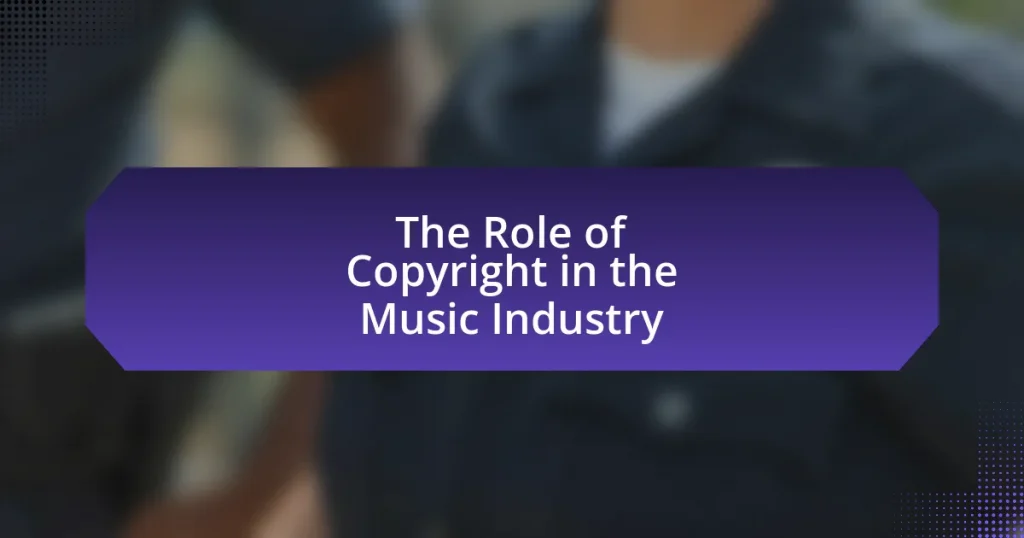Copyright is a fundamental legal framework that protects the intellectual property rights of creators in the film production industry. This article examines the significance of copyright in safeguarding original works such as scripts, music, and visual content, ensuring filmmakers maintain exclusive control and can monetize their creations. It discusses the types of works protected under copyright law, the implications of copyright infringement, and the economic benefits that copyright provides to filmmakers. Additionally, the article addresses the challenges filmmakers face regarding copyright, the role of licensing, and best practices for navigating copyright issues effectively.

What is the Role of Copyright in Film Production?
Copyright plays a crucial role in film production by protecting the intellectual property rights of creators, ensuring they have exclusive control over their work. This legal framework allows filmmakers to secure their original scripts, music, and visual content from unauthorized use or reproduction, thereby incentivizing creativity and investment in the film industry. For instance, the U.S. Copyright Act of 1976 grants creators the right to reproduce, distribute, and display their works, which is essential for generating revenue through licensing and sales. This protection fosters a sustainable environment for artistic expression and innovation within the film sector.
How does copyright protect film creators and their works?
Copyright protects film creators and their works by granting them exclusive rights to reproduce, distribute, and display their films. This legal framework ensures that creators can control how their works are used and can benefit financially from their creations. For instance, under the U.S. Copyright Act of 1976, filmmakers automatically receive copyright protection upon the creation of their work, which lasts for the life of the creator plus 70 years. This protection prevents unauthorized use, such as copying or distributing the film without permission, thereby safeguarding the creator’s intellectual property and encouraging further artistic innovation.
What types of works are protected under copyright law in film?
Copyright law in film protects various types of works, including the film itself, scripts, music, and visual elements. The film is considered a composite work, encompassing audiovisual elements, which are protected as a whole. Additionally, the screenplay or script is protected as a literary work, while original music composed for the film is protected as a musical work. Visual elements, such as set designs and costumes, are also protected as artistic works. These protections are established under the U.S. Copyright Act, which grants exclusive rights to creators, ensuring they can control the use and distribution of their works.
How does copyright infringement occur in the film industry?
Copyright infringement in the film industry occurs when a film utilizes copyrighted material without permission from the rights holder. This can happen through unauthorized use of scripts, music, footage, or characters from existing works, leading to legal disputes. For instance, the case of “Bright Tunes Music Corp. v. Harrisongs Music, Ltd.” illustrates how George Harrison was found liable for subconsciously copying a melody from another song, highlighting the legal ramifications of copyright violations. Such infringements can result in significant financial penalties and damage to a filmmaker’s reputation.
Why is copyright important for the film industry?
Copyright is crucial for the film industry because it protects the intellectual property rights of creators, ensuring they receive recognition and financial compensation for their work. This legal framework allows filmmakers, writers, and artists to control the distribution and reproduction of their films, preventing unauthorized use and piracy. According to the Motion Picture Association, the film industry contributes over $200 billion to the global economy, highlighting the importance of copyright in safeguarding these economic interests and fostering creativity. Without copyright protection, the incentive for innovation and investment in film production would diminish, ultimately harming the industry and its stakeholders.
What economic benefits does copyright provide to filmmakers?
Copyright provides filmmakers with significant economic benefits by granting them exclusive rights to their creative works, which allows for monetization through various channels. These exclusive rights enable filmmakers to control the distribution, reproduction, and public performance of their films, leading to revenue generation from box office sales, streaming services, and licensing agreements. For instance, the global box office revenue for films reached approximately $42.5 billion in 2019, illustrating the financial impact of copyright protection on filmmakers’ earnings. Additionally, copyright helps secure funding and investment, as potential investors are more likely to support projects that have legal protections in place, ensuring a return on their investment.
How does copyright influence creative freedom in film production?
Copyright significantly influences creative freedom in film production by establishing legal protections for original works, which can both empower and restrict filmmakers. On one hand, copyright allows creators to control the use of their intellectual property, ensuring they receive recognition and financial benefits from their work. This protection encourages innovation and investment in new projects, as filmmakers can confidently develop original content without fear of unauthorized use. On the other hand, copyright can impose limitations on creative expression, particularly when it comes to derivative works or adaptations, as filmmakers must navigate licensing agreements and potential infringement issues. For instance, the case of “The Hunger Games” series illustrates how adaptations must carefully balance fidelity to the source material with creative interpretation, often requiring negotiations with original authors or rights holders. Thus, while copyright fosters a secure environment for creativity, it also necessitates careful consideration of legal boundaries that can shape the direction of film projects.
What challenges do filmmakers face regarding copyright?
Filmmakers face significant challenges regarding copyright, primarily due to the complexities of intellectual property laws and the risk of infringement. The intricate nature of copyright law can lead to confusion about what constitutes fair use, especially when incorporating existing works into new films. For instance, filmmakers often struggle with obtaining licenses for music, scripts, or visual elements, which can be costly and time-consuming. Additionally, the rise of digital media has increased the likelihood of unauthorized distribution and piracy, further complicating the protection of original content. According to a report by the U.S. Government Accountability Office, copyright infringement costs the U.S. economy billions annually, highlighting the financial stakes involved for filmmakers.
How do international copyright laws affect film production?
International copyright laws significantly influence film production by establishing the legal framework that protects creators’ rights across borders. These laws ensure that filmmakers can secure exclusive rights to their works, preventing unauthorized use and distribution in different countries. For instance, the Berne Convention, which has been ratified by over 170 countries, mandates that works created in one member country receive automatic copyright protection in all other member countries, thus facilitating international distribution and collaboration. This legal protection encourages investment in film projects, as producers are assured that their intellectual property will be safeguarded globally, which is crucial in an industry where piracy and infringement can lead to substantial financial losses.
What are common misconceptions about copyright in film?
Common misconceptions about copyright in film include the belief that copyright protects ideas rather than the expression of those ideas, and that once a film is created, it is automatically protected without any formal registration. Copyright law specifically protects the tangible expression of creative works, such as scripts, music, and visual elements, rather than the underlying concepts or themes. Additionally, while copyright protection is automatic upon creation, registering a work with the U.S. Copyright Office provides legal advantages, such as the ability to sue for statutory damages and attorney’s fees. These misconceptions can lead to confusion regarding the rights of filmmakers and the legal protections available to their works.
How can filmmakers effectively navigate copyright issues?
Filmmakers can effectively navigate copyright issues by conducting thorough research on copyright laws and obtaining necessary licenses for any copyrighted material used in their films. Understanding the distinction between fair use and infringement is crucial; for instance, fair use allows limited use of copyrighted material without permission under specific circumstances, such as commentary or criticism. Additionally, filmmakers should consider creating original content or using public domain works to avoid copyright conflicts. According to the U.S. Copyright Office, works published before 1923 are in the public domain, providing a resource for filmmakers seeking to avoid copyright issues. Engaging legal counsel specializing in intellectual property can further ensure compliance and protection of their creative works.
What steps should filmmakers take to secure their copyrights?
Filmmakers should register their works with the U.S. Copyright Office to secure their copyrights. This formal registration provides legal evidence of ownership and is necessary for filing a lawsuit against infringement. Additionally, filmmakers should include copyright notices on their films and related materials, which serves as a public declaration of their rights. They should also maintain thorough documentation of the creation process, including scripts, production notes, and contracts with collaborators, to establish a clear chain of authorship. These steps are crucial as they enhance the enforceability of copyright claims and protect against unauthorized use.
How can filmmakers avoid copyright infringement in their projects?
Filmmakers can avoid copyright infringement by obtaining proper licenses for any copyrighted material they wish to use in their projects. This includes securing rights for scripts, music, images, and any other content that is not originally created by the filmmakers. According to the U.S. Copyright Office, using copyrighted material without permission can lead to legal consequences, including lawsuits and financial penalties. Additionally, filmmakers should consider creating original content or using public domain works, which are free from copyright restrictions, to further mitigate the risk of infringement.
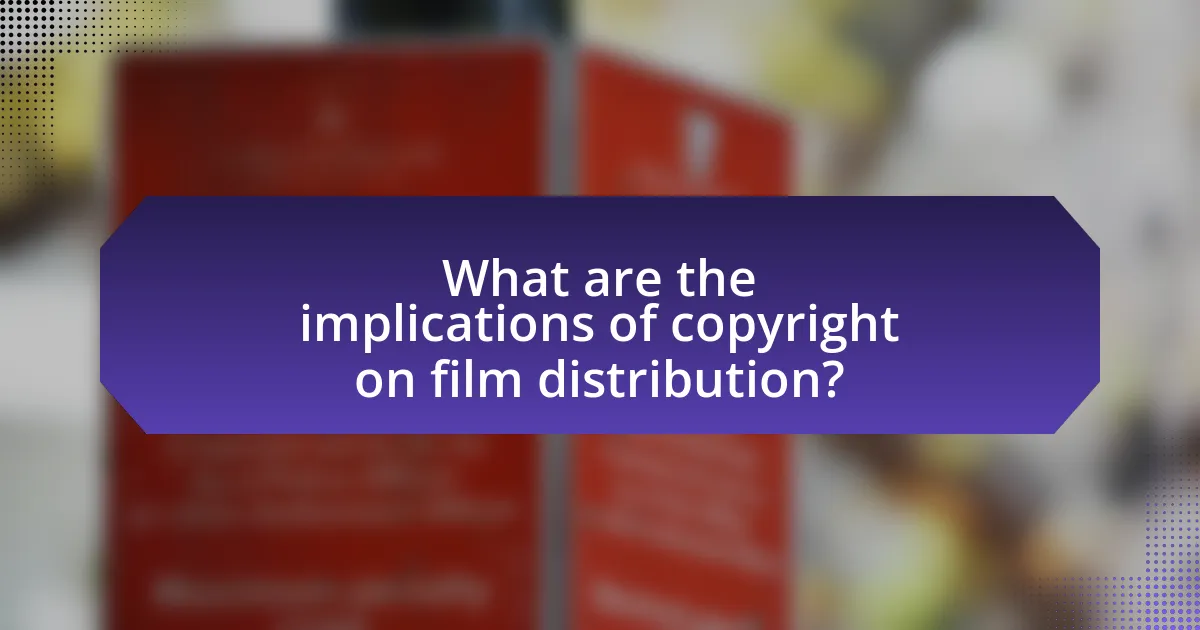
What are the implications of copyright on film distribution?
Copyright significantly impacts film distribution by granting exclusive rights to creators, which control how films are distributed and monetized. This exclusivity ensures that filmmakers can protect their intellectual property from unauthorized use, thereby allowing them to negotiate distribution deals that maximize revenue. For instance, the Copyright Act of 1976 in the United States provides filmmakers with the right to reproduce, distribute, and publicly display their works, which directly influences the terms under which films are released in various markets. Additionally, infringement of copyright can lead to legal actions that disrupt distribution channels, as seen in high-profile cases where unauthorized streaming platforms faced lawsuits for distributing copyrighted films without permission. Thus, copyright serves as a crucial legal framework that shapes the landscape of film distribution, ensuring that creators retain control over their works while also influencing market dynamics.
How does copyright affect the distribution rights of films?
Copyright grants filmmakers exclusive rights to distribute their films, meaning that only the copyright holder can authorize the distribution of copies. This legal protection ensures that filmmakers can control how their work is shared and monetized, preventing unauthorized distribution that could harm their financial interests. For instance, under the U.S. Copyright Act, the copyright owner has the right to reproduce, distribute, and publicly display the film, which is crucial for maintaining the integrity and profitability of the film industry.
What are the different types of distribution rights in film?
The different types of distribution rights in film include theatrical rights, television rights, home video rights, digital distribution rights, and international distribution rights. Theatrical rights allow a film to be shown in cinemas, while television rights grant access for broadcasting on TV networks. Home video rights pertain to the sale or rental of physical copies, such as DVDs and Blu-rays, and digital distribution rights cover streaming and download services. International distribution rights enable the film to be released in foreign markets. Each type of right is crucial for maximizing a film’s revenue and reach, as evidenced by the significant income generated from various distribution channels, which can account for up to 80% of a film’s total earnings.
How can copyright impact the profitability of film distribution?
Copyright significantly impacts the profitability of film distribution by providing legal protection for the intellectual property of filmmakers, which in turn influences revenue generation. When copyright is enforced, it prevents unauthorized use and distribution of films, ensuring that creators can monetize their work through various channels such as box office sales, streaming services, and merchandise. For instance, the Motion Picture Association reported that the U.S. film industry generated over $11 billion in box office revenue in 2019, largely due to the protection afforded by copyright laws that deter piracy and unauthorized distribution. Thus, strong copyright enforcement directly correlates with increased profitability for film distributors by safeguarding their investments and enabling them to capitalize on their creative content.
What role does licensing play in film copyright?
Licensing is essential in film copyright as it grants permission for the use of copyrighted material, ensuring that creators can legally exploit their works. Through licensing agreements, filmmakers can obtain rights to use scripts, music, and other intellectual properties, which is crucial for the production and distribution of films. For instance, the licensing of music can significantly enhance a film’s appeal and marketability, as seen in successful films that feature popular soundtracks. Additionally, licensing helps protect the rights of original creators by providing a legal framework for compensation and control over how their works are used, thereby fostering a fair creative environment in the film industry.
How do licensing agreements work in the film industry?
Licensing agreements in the film industry are legal contracts that grant permission for one party to use the intellectual property of another party, typically involving the rights to distribute, exhibit, or adapt a film. These agreements outline the terms under which the rights holder allows the licensee to use the film, including duration, territory, and financial arrangements such as royalties or flat fees. For example, a production company may license a film to a streaming service, allowing the service to stream the film to its subscribers while paying a predetermined fee to the production company. Licensing agreements are essential for protecting the rights of creators and ensuring that they receive compensation for their work, as evidenced by the fact that the global film industry generated approximately $42 billion in revenue from licensing and distribution in 2020.
What are the risks associated with licensing copyrighted material?
Licensing copyrighted material carries several risks, including potential legal disputes, financial liabilities, and reputational damage. Legal disputes may arise if the licensing agreement is not clearly defined, leading to claims of infringement or breach of contract. Financial liabilities can occur if the licensee fails to comply with the terms, resulting in penalties or the need to pay additional fees. Reputational damage may stem from negative public perception if the licensed material is associated with controversial content or if the licensing process is perceived as unethical. These risks highlight the importance of thorough due diligence and clear contractual agreements in the licensing process.
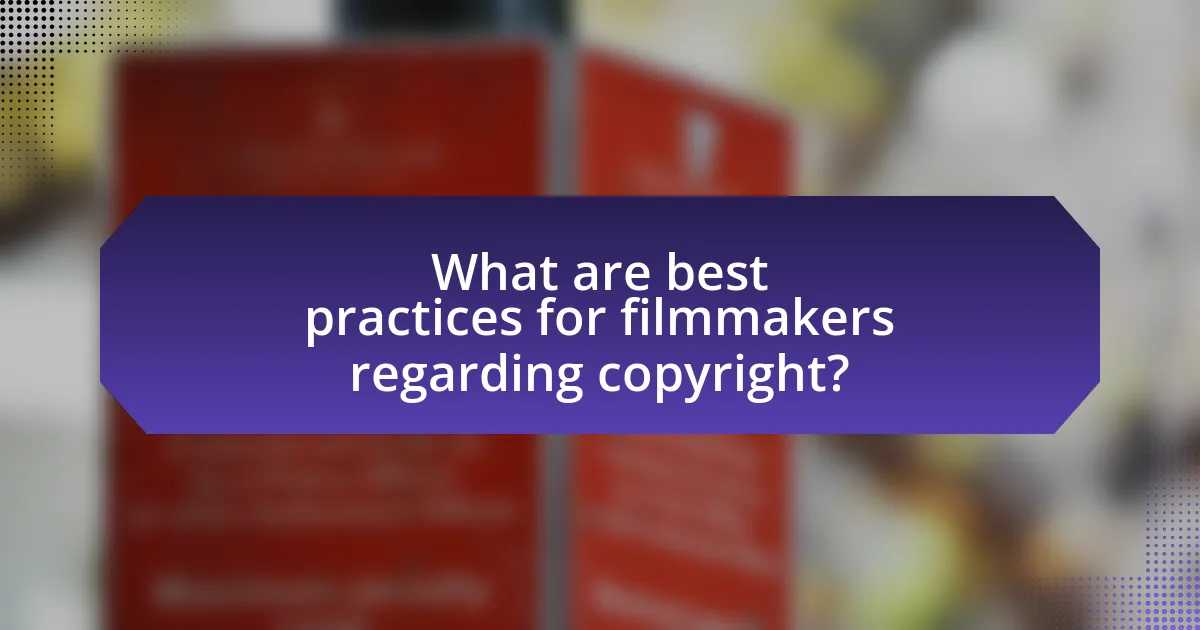
What are best practices for filmmakers regarding copyright?
Filmmakers should secure copyright for their original works to protect their creative content. This involves registering the film with the U.S. Copyright Office, which provides legal evidence of ownership and the ability to enforce rights against infringement. Additionally, filmmakers must obtain licenses for any third-party content, such as music or scripts, to avoid legal disputes. According to the U.S. Copyright Office, registration is crucial as it allows for statutory damages and attorney fees in case of infringement. Filmmakers should also keep detailed records of all agreements and permissions related to their work to ensure compliance and facilitate any necessary legal actions.
How can filmmakers educate themselves about copyright laws?
Filmmakers can educate themselves about copyright laws by accessing resources such as online courses, legal workshops, and industry seminars focused on intellectual property. These educational opportunities often cover the fundamentals of copyright, including rights management, fair use, and licensing agreements, which are crucial for film production. For instance, organizations like the American Bar Association and the International Documentary Association offer specific programs and materials that address copyright issues relevant to filmmakers. Additionally, filmmakers can consult legal texts and guides, such as “Copyright Law for Dummies” by Alan S. Gassman, which provide comprehensive insights into copyright regulations and their application in the film industry.
What resources are available for understanding copyright in film?
Resources available for understanding copyright in film include the U.S. Copyright Office website, which provides comprehensive guidelines and legal information regarding copyright laws applicable to film. Additionally, the book “Copyright Law for Dummies” by Alan S. Gassman offers accessible explanations of copyright principles relevant to filmmakers. The American Bar Association also publishes articles and resources that detail copyright issues in the film industry. Furthermore, online courses from platforms like Coursera and Udemy cover copyright law specifically tailored for filmmakers, enhancing practical understanding. These resources collectively offer a solid foundation for grasping the complexities of copyright in film production.
How can filmmakers stay updated on changes in copyright legislation?
Filmmakers can stay updated on changes in copyright legislation by subscribing to legal newsletters, attending industry seminars, and following relevant organizations such as the Motion Picture Association. These resources provide timely information on legislative changes and legal interpretations that affect copyright in film production. For instance, the U.S. Copyright Office regularly publishes updates and guidelines that filmmakers can access to understand new laws and amendments. Additionally, engaging with legal professionals who specialize in intellectual property can offer personalized insights and updates tailored to specific projects.
What practical tips can filmmakers follow to protect their work?
Filmmakers can protect their work by registering their films with the U.S. Copyright Office, which provides legal proof of ownership and the ability to enforce rights against infringement. Additionally, filmmakers should use contracts to clearly define rights and responsibilities with collaborators, ensuring that all contributions are documented and ownership is established. Filmmakers can also watermark their content and utilize digital rights management (DRM) technologies to prevent unauthorized distribution. These practices are supported by the Copyright Act of 1976, which emphasizes the importance of registration and documentation in protecting creative works.
How should filmmakers document their creative processes for copyright purposes?
Filmmakers should document their creative processes through detailed records of their work, including scripts, storyboards, production notes, and dated drafts. This documentation serves as evidence of the originality and timeline of their creative output, which is crucial for establishing copyright claims. For instance, maintaining a dated journal of ideas, sketches, and revisions can demonstrate the evolution of a project, reinforcing the filmmaker’s ownership. Additionally, registering these works with the U.S. Copyright Office provides legal protection and further solidifies the filmmaker’s rights, as registration is a prerequisite for filing a lawsuit for infringement.
What are the best practices for collaborating with others while respecting copyright?
The best practices for collaborating with others while respecting copyright include obtaining permission for any copyrighted material used, clearly defining ownership rights in collaboration agreements, and providing proper attribution to original creators. Obtaining permission ensures that all parties are legally protected and acknowledges the rights of the original creators, which is essential in film production where multiple contributors are involved. Clearly defining ownership rights in collaboration agreements helps prevent disputes over intellectual property, as it outlines who owns what and how profits will be shared. Providing proper attribution not only respects the work of others but also enhances credibility and fosters a culture of respect within the creative community.

